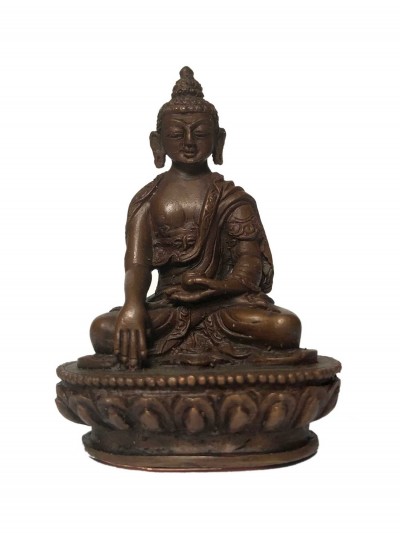Loading Content..

Akshobhya Buddha, known as the Unshakable One, is one of the Five Dhyani Buddhas in Tibetan Buddhist tradition. He represents the cosmic element of consciousness and embodies qualities such as fearlessness, patience, and transformation. Akshobhya is revered as a symbol of steadfastness and is associated with the purification of negative emotions and the attainment of enlightenment. Devotion to Akshobhya Buddha plays a significant role in Tibetan Buddhist practice.
Iconography:
Akshobhya Buddha is often depicted as a radiant blue figure, representing the unchanging nature of the awakened mind. He is seated in the vajra posture, with his right hand touching the earth in the Bhumisparsha Mudra, symbolizing his enlightenment and calling the earth his witness. His left-hand rests in the meditation mudra, holding a vajra, a symbol of spiritual power and enlightenment.
History:
Akshobhya Buddha's origins can be traced back to ancient Buddhist texts and teachings. His significance grew within the Vajrayana tradition of Tibet, where he became an important figure associated with transformation and the purification of negative emotions. Akshobhya's practice and teachings became integrated into the rich tapestry of Tibetan Buddhist philosophy and meditation practices.
Temples and Monasteries:
While there might not be specific temples dedicated solely to Akshobhya Buddha in Nepal, there are monasteries and centers around the world that honor this deity. Some notable examples include the Borobudur Temple in Indonesia, which houses a significant Akshobhya statue, and the Shingon Buddhist temples in Japan, where Akshobhya is revered as one of the central deities.
Benefits of Practicing Akshobhya:
The devotion and practice of Akshobhya Buddha offer various benefits to practitioners. By cultivating qualities such as patience, fearlessness, and equanimity, individuals can transform negative emotions, purify karma, and develop a deeper sense of inner stability and peace. Akshobhya's practice is also believed to be helpful in overcoming anger, aggression, and attachments, leading to the attainment of enlightenment.
How to Practice:
To practice Akshobhya Buddha, individuals can engage in meditation, recitation of mantras, visualization, and contemplation on the qualities and teachings associated with this deity. Following the guidance of a qualified teacher or lama is recommended to deepen one's understanding and experience of Akshobhya's transformative practice.
Mantras of Akshobhya Buddha:
The primary mantra associated with Akshobhya is:
"Om Akshobhya Hum"
Reciting this mantra during meditation or as part of a dedicated practice can invoke the qualities and blessings of Akshobhya Buddha, aiding in the purification of negative emotions and the cultivation of wisdom and fearlessness.
Loading..
Please wait for the page to fully load for optimal functionality.
Loading Content..